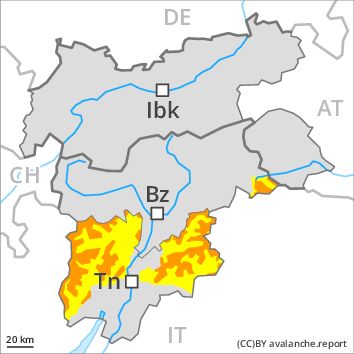Regions
Sexten Dolomites, Latemar, Southern Adamello, Primiero - Pale di S. Martino, Adamello - Presanella, Northern Brenta - Peller, Western Nonsberg Alps, Southern Brenta, Fassa Valley, Sole, Pejo and Rabbi, Southern Lagorai, Northern Lagorai, Maddalene, Paganella, Pine' - Mocheni Valley
AM
Danger level
Avalanche Problem
Wet snow, N-NE-E-SE-S-SW-W-NW
Persistent weak layer above 2200m, N-NE-NW
PM
Danger level
Avalanche Problem
Wet snow, N-NE-E-SE-S-SW-W-NW
Persistent weak layer above 2200m, N-NE-NW
The danger of moist and wet avalanches will increase during the day.
Especially on rocky sunny slopes and on wind-loaded slopes numerous medium-sized and, in isolated cases, large natural wet avalanches are possible as a consequence of warming. The danger of wet and gliding avalanches will increase during the day. Weak layers exist in the snowpack in particular on wind-loaded slopes. This applies on steep northeast, north and northwest facing slopes above approximately 2200 m adjacent to ridgelines. These avalanche prone locations are difficult to recognise. The sometimes fresh snow-covered wind slabs are to be evaluated with care and prudence in particular in very steep terrain. In the regions exposed to heavier precipitation the avalanche prone locations are more prevalent and larger. As a consequence of warming, the likelihood of moist and wet avalanches being released will increase gradually in particular on steep slopes at intermediate altitudes.
Snowpack
dp 10: springtime scenario
The older wind slabs have bonded well with the old snowpack. In very isolated cases weak layers exist in the old snowpack on shady slopes, in particular in areas where the snow cover is rather shallow. In some places wind slabs are lying on soft layers, in particular on shady slopes above approximately 2400 m. At low altitude a little snow is lying.
Tendency
Slight decrease in avalanche danger as the snowfall level drops.

